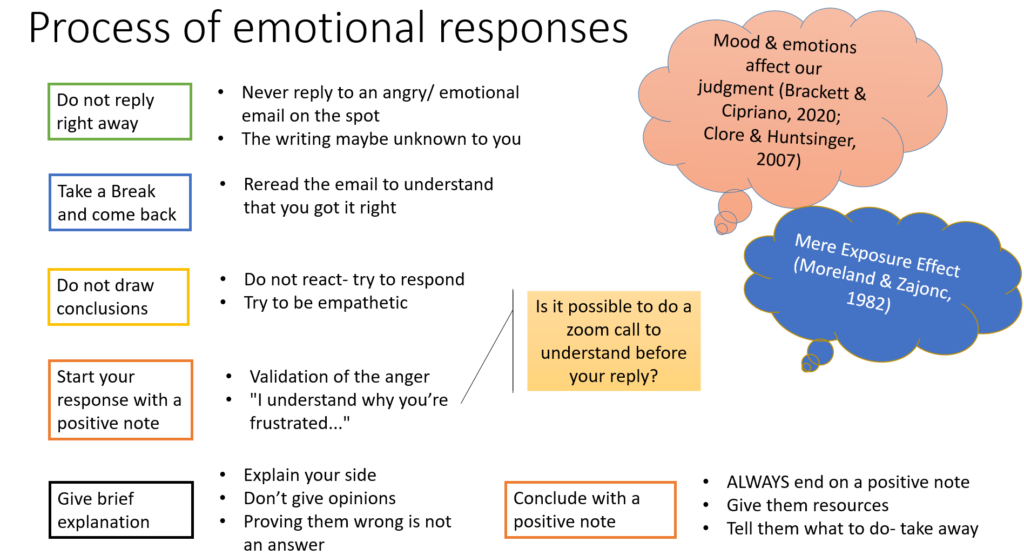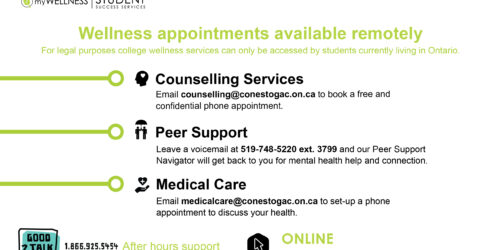Reacting and Responding to Student E-mails, Especially During End-of-Semester Stress
By Sara Kafashan and Kathryn Brillinger
Please email teachingandlearning@conestogac.on.ca with additional scenarios to add.
The end of semester can be a particularly stressful and busy time for anyone in a post-secondary institution. With final exams and assignments for students, as well as marking and course wrap-up responsibilities for faculty, it’s common to feel (Zoom) fatigued and low on time, energy, and resources. One pertinent issue that tends to arise during this stress and tiredness is a surge of e-mails from distressed students. In this post, we share some tips and strategies to respond to student e-mails, particularly during stressful points in the semester. (For more on responding to student e-mails in the beginning of the semester, see this post).
General Practices for Student Emails
- Reply in a timely fashion: According to the E-mail, Voice Mail and Corporate Calendar Policy, you are expected to return all messages within two (2) working days of receipt. Students often expect, and prefer, a quicker turnaround, so be sure to set expectations in the first weeks of the semester. For example, indicate in writing that, “Questions about assignments must be received at least two working days before the due date or they will not likely be responded to in time for you to receive guidance.” Remind students that you are under no obligation to reply on evenings or weekends. But, note that students may find it hard to wait: Gonzalez-Rameriz et al. (2021) looked at the acute and chronic stress many students are experiencing in the pandemic and found it impacted their behaviours and states.
- Replying to academic disputes: In the case of a mark query, the Academic Dispute Resolution and Appeal Procedure indicates that, “The faculty member will respond in writing to the student within five (5) working days of receipt of the concern.” It is best to send a quick reply within two (2) working days acknowledging that they have asked for a review of the marking, etc. and then be sure to look at the item in question and reply within five (5) working days. For more information on this topic, as it pertains to the suspected student use of generative AI, see this post.
- Deciding on Providing Extra Work for Marks: Your Chair and Program Team should have provided direction on leeway with supplementals or make up work from the start of the semester. Refer back to your Program Handbook so that the student knows your decision is not arbitrary. Elsalem et al. (2020) found online exams added additional stress to students and impacted some of their coping behaviours.
- Replying to students who send multiple emails: If a student sends you continual messages, it is best to reply once and refer them to other resources. You can create a standard message to repeated emails that refers students to Student Services, such as Counselling, and indicates that the repeated messages are problematic and are being noted in case this continues or escalates. Remind the student that you will reply more fully within five (5) days if this is a mark concern.
- Replying to students who copy many others: This copying causes additional stress as there is a possibility of losing face even if what the student said is not accurate. It is recommended that you “Reply all” once, stating that you and your Chair are handling the matter and a response copied to the Chair will be forthcoming.
- Replying to students who reference harm to self or others: One of the challenges faculty have experienced is messages such as “I cannot live like this” or “my family will kill me” or others to that effect. It is hard for you not to worry. Suggest to the student you will fill the Care Team form in for them as you are worried for them. To learn more about this topic, read this post.
- Replying to other mediums: While not included in any formal policy, you are also expected to respond to student messages on eConestoga or Microsoft Teams unless you have set clear expectations for how such vehicles of communication will be handled.
- Including Student Success resources: Including Student Success resources, such as information about Counselling and Accessible Learning, directly into email signatures and auto-replies is a good idea to get in front of stressful semester points and student distress.
Factors that Impact Our Responses & Steps to Mitigate
Many factors impact our responses to distressed or emotional student emails. One of the most important factors is our own current state. Research shows that educators experiencing negative emotions and mood (e.g., anxiety and stress) are more likely to evaluate (and respond to) students less favorably than educators experiencing positive emotions and mood, such as joy and interest (Brackett & Cipriano, 2020; Clore & Huntsinger, 2007). Even what seems familiar or recognizable to us can have an impact our interpretations, reactions, and responses (Mere Exposure Effect; Moreland & Zajonc, 1982). For example, educators tend to award a higher grade to papers written by students with traditional (and familiar) names as compared to students with non-traditional (and hence, unfamiliar) names (Nick, 2017). With all of this in play, how can faculty respond appropriately to student emails?
First, it’s important to note that we can do things even before we reply to emotional emails (see Figure 1 below). Never reply to an email when you’re emotionally charged (e.g., feeling angry or upset), instead wait until your emotions have settled. In this time of simmering our emotions, try not to draw conclusions. Focus, instead, on trying to be empathetic towards the student. Once we get to responding, it might even be worthwhile to try set up a zoom call or meeting with the student before you respond to the issue at hand. This would allow you to get a better sense of the context, the student’s perspective, and build rapport. In writing your reply, start your message with a positive note. Validating the student’s experience, for example “I understand why you’re feeling frustrated”, goes a long way in building trust and common ground for a fruitful conversation. Giving a brief explanation of your side, without taking sides, proving the student wrong or focusing on opinions will also help keep an objective tone. And lastly, always end on a positive note, summarize, and incorporate appropriate resources.
See below for a summary step-by-step guide graphic.

References
Brackett, M., & Cipriano, C. (2020). Emotional Intelligence Comes of Age. Cerebrum : The Dana Forum on Brain Science, 2020.
Clore, G. L., & Huntsinger, J. R. (2007). How emotions inform judgement and regulate thought. Trends in Cognitive Sciences, 11, 393-399.
Elsalem, L., Al-Azzam, N., Jum’ah, A. A., Obeidat, N., Sindiani, A. M., & Kheirallah, K. A. (2020). Stress and behavioral changes with remote E-exams during the Covid-19 pandemic: A cross-sectional study among undergraduates of medical sciences. Annals of Medicine and Surgery, 60, 271–279. https://doi.org/10.1016/j.amsu.2020.10.058
Gonzalez-Rameriz, J., Mulqueen, K., Zealnad, R., Silverstein, S., Bushell, S. & Ladda, S. (2021). Emergency online learning: College students’ perceptions during the Covid-19 crisis. College Student Journal, 55(1), 29–46.
Moreland, R. L., & Zajonc, R. B. (1982). Exposure effects in person perception: Familiarity, similarity, and attraction. Journal of Experimental Social Psychology, 18(5), 395–415. https://doi.org/10.1016/0022-1031(82)90062-2
Nick, I. M. (2017). Names, grades, and metamorphosis: A small-scale socio-onomastic investigation into the effects of ethnicity and gender-marked personal names on the pedagogical assessments of a grade school essay. Names, 65(3), 129-142. 2122-Article Text-4323-1-10-20201216.pdf
The long tail of an unprecedented crisis. (2020, November 27). Chronicle of Higher Education, 67(7), 16–18.



